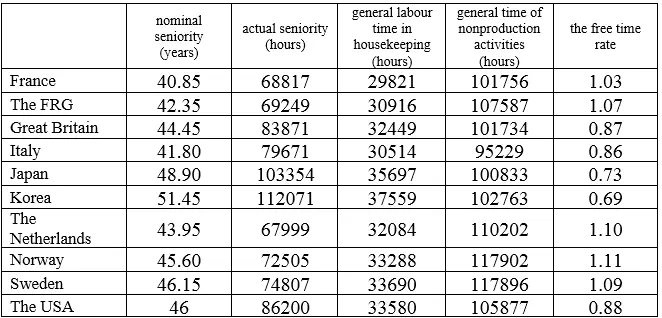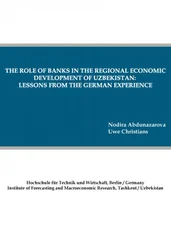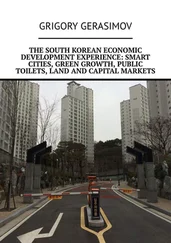Obviously, the long-term tendency to working time reduction also acted before 1970, though it was broken in different periods (for example, during the Second World War). As economic activities of employees of different age cover decades that differ in working hours volumes significantly, so actual seniority of employees of the countries tends to decrease. This is the final expression of the regularity of working time reduction that summarizes its realization within the whole system of periods of employees’ working activities.
For a more exact quantitative illustration of this regularity let us take into consideration the dynamics of nominal seniority in the examined countries. As for the average effective age of retirement, it decreased from 68.4 to 63.2 for men and from 66.4 to 61.1 for women in the countries of the OECD since 1970 till 1998. Since 1999 it increased a bit up to 63.9 for men and 62.6 for women in 2011 [36]. During the last decades extension of the scope of young people with higher education neutralized the tendency to increasing in nominal seniority to a certain extent. Consequently, during last more than forty years nominal seniority has, in general, decreased what also assisted in decreasing in actual seniority.
As a result, according to our calculations, for example, in the FRG those employees who retired in 2012 had been working for 70000-75000 hours for their working life – as compared to 120000 hours worked by pensioners of 1970. Actual seniority of employees born in 1951 was 3% less than actual seniority of employees born in 1941. The tendency to reduction of total time worked on average by employees of different generations for their working life was typical for other economically developed countries during the 20 thcentury and in the beginning of the 21 stcentury.
Decreasing in actual seniority was extended to industrial employees too. That is why the tendency to approximation of the social economic state of main groups of employees is typical for all periods of their labour activities.
The noted changes did not abolish social division of labour between industrial employees and employees occupied in rendering services. At combination of these kinds of activities by all able-bodied people average duration of actual seniority would be slightly less (for example, because of absence of unemployment). Anyway, production labour would not be more than 35% of the present value of this duration because the shift in labour expenditures in favor of the services sphere began earlier 1970s. Certainly, on the criteria of the existing potential of economic development actual seniority of industrial employees is extensively enduring. The optimality of seniority of employees occupied in the nonproduction sphere also remains questionable.
Reduction of working time is a form of increasing in welfare of working members of the society only when it is combined with ensuring social needs with goods and means of production. Otherwise, – with growth of material neediness – nonworking time loses its modification of free time, and that is why it stops being an element of welfare.
Examination of actual seniority duration maximally grades impact of crisis periods on the volume of worked time. An economic crisis did not last for decades in any developed country. Still, we need a direct confirmation to the fact that working time reduction was an element of increasing in social welfare.
It is reasonable to compare the dynamics of decreasing in worked time to increasing in labour productivity per one worked hour (table 45).
As it follows from the data of table 45, within all the studied periods in all the countries reduction of the number of worked hours was accompanied by outstripping growth of labour productivity per one worked hour.
Table 45
The Dynamics of Annual Real GDP per One Worked Hour and the Average Number of Annual Working Hours per One Employee in Economically Developed Countries (%)

Source : calculated according to the data of the OECD
Only in some crisis years – in 2009 in the FRG, in 2008 and 2009 in Great Britain, in 2009 in the Netherlands and in 1974 and 1982 in the USA – reduction of worked time went against decreasing in returns from each hour of labour. But such “market collapses” did not abolish the general tendency to outstripping growth of labour productivity. This is another confirmation of the following idea: “The fundamental property of any labour is to produce a result surpassing costs” [37].
Consequently, reduction of actual seniority is quite compatible with growth of social welfare, in general, and that is why it is compatible with increasing in material well-being of employees.
As within less enduring periods of labour activities, to assess conditions of employees’ development during their seniority it is necessary to take into consideration labour time in housekeeping. Accordingly, calculation of the free time rate during seniority is reasonable.
The Free Time Rate within Seniority
When calculating the free time rate within the examined period, we shall use the above values of actual seniority (supposing its equality for employees occupied in different spheres of the economy). The part of general time of paid labour in the sphere of social production will be taken as 35%, and in the services sphere it will be taken as 65% at possible combination of different kinds of activities by employees.
When determining the volume of labour in housekeeping, we shall proceed from its fixed average daily value equal to 2 hours. This prerequisite reflects the fact that in developed countries providing domestic labour with home appliances had been finished until the beginning of 1970s.
There are differences in volumes of both paid and domestic labour fulfilled, on one hand, by women and, on the other hand, by men. And in this case we shall use average indices slightly overrating labour duration of women in social economy and of men in household.
Let us fix the value of the studied index for industrial employees.
Table 46
The Free Time Rate of Industrial Employees for the Period of Seniority Finished in 2012

As it follows from the above data, in a half of the examined countries the analyzed index exceeded 1, and in the other half of the countries it remained lower than 1, in Korea and Japan it was significantly lower than 1.
Those European countries, for which policy of active redistribution of incomes for smoothing economic inequality out is typical, are in the vanguard. In that way, orientation towards overcoming extreme inequality does not limit itself with the sphere of incomes only, but it extends to improvement of the ratio between working and nonworking time of industrial employees.
Great Britain and the USA, where the level of social economic inequality is seriously higher than in the noted European countries by other parameters, lag behind.
Korea and Japan, one earlier and the other one later, were overtaking the leaders in the volumes of industrial production. Obviously, overcoming the gap in output was attained owing to more enduring working time. At the same time, during last decades employees of these countries, especially in Korea, more and more actively advocate working time reduction, seeking its approach to the level typical for leading countries.
Let us note that the rank of the countries, depending on the level of the free time rate during seniority, generally corresponds to the rank in respect of the annual free time rate in 2007, and the absolute value of the latter is a bit higher than the value of the rate for the whole labour life. It shows that, on one hand, this situation is a result of the long-term tendencies, on the other hand, it is an appearance of the regularity of working time reduction.
Читать дальше














